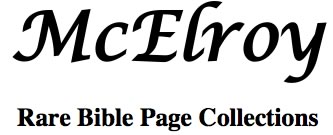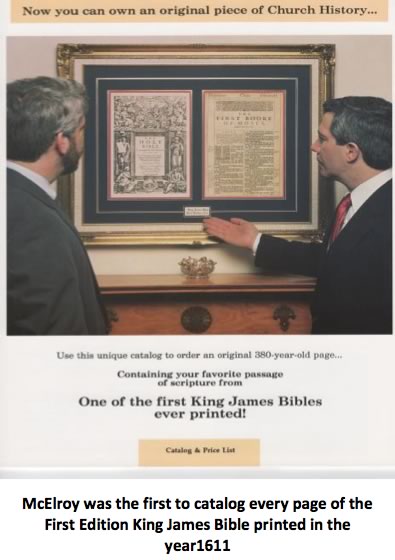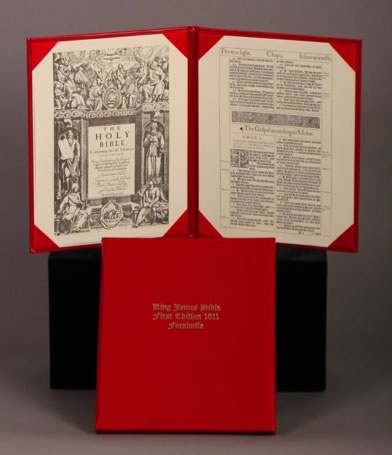
I co-founded McElroy Rare Bible Page Collections with my brothers, Dan and Mark, in 1990 to market original leaves of a first edition King James Bible printed in AD 1611.
Known as “The Great ‘HE’ Bible” and printed in London by the King’s printer, Robert Barker, these original leaves were from an incomplete copy of one of the Great “He” Bibles, so-called by scholars because of the rendering “He went into the citie” in Ruth 3:15. (Current editions correctly read “She.”) First printings are rare and valuable.
An intact first printing King James Bible (with an exceptionally beautiful binding) sold at Sotheby’s in November 1989 for $143,000. Even fragmented copies can sell for tens of thousands of dollars––if you could ever find one.
Here’s the story… I
n the late 1980s I received a solicitation through a financial newsletter to purchase an original leaf from a first edition King James Bible. I was astonished. The newsletter suggested that I could choose the particular page that had a verse I especially liked. I thought it was really great. I had to have one. As I recall, I ordered the page containing Isaiah 9:6:
For unto us a child is born, unto us a son is given: and the
government shall be upon his shoulder: and his name shall
be called Wonderful, Counseller, The mighty God, The
everlasting Father, The Prince of Peace.
I like this verse because it is a great description of the Lord Jesus Christ. What’s amazing is that it was written about 700 years before he was born.
What came out of this purchase was…
McElroy Rare Bible Page Collections
 Because we had been successful in the cellular telephone industry, I thought it would be great to do the same thing––acquire an original 1611 King James Bible and offer leaves from it. I thought there would be lots of people who would really desire to own one since the King James Bible is so well-loved.
Because we had been successful in the cellular telephone industry, I thought it would be great to do the same thing––acquire an original 1611 King James Bible and offer leaves from it. I thought there would be lots of people who would really desire to own one since the King James Bible is so well-loved.
The book was very expensive. We were finally able to obtain an incomplete original 1611 King James Bible for the hefty sum of $71,000. But now came the more interesting and formidable challenge––offering the leaves for sale.
I did what nobody had done before … I cataloged and featured every single leaf of the 66 books contained in this King James Bible.
I had to individually price them. To do so, I had to find something of interest on each page (which, since it is the word of God, wasn’t that difficult), use that as the identifier, and then appropriately price the leaf.
The Presentation
We had to buy linen bordered frames in volume.
We located a skilled framer and had him do exquisite triple matting (we even had a cutout in the back so that you can see the back of the original leaf.)
Then we reproduced the title page and sold the leaves on a first-come, first-served basis. [caption]I was the first to catalog every page of the 1611 First Edition King James Bible.
The Promotion
We ran full-page advertising in publications such as in Biblical Archaeology Review, Bible Review, Christian History Magazine, Robb Report, Arts and Antiques, Sword of the Lord, and Preaching Magazine.
It was an extremely time-consuming and expensive project. But most new businesses are. Usually they take twice as long, cost twice as much, and have a whole bunch of hidden expenses that you never could have anticipated.
Some call it “the school of hard knocks,” others “Life University.” Whatever you call it, I was glad we had the opportunity to do it. It’s continuing education after you graduate from school.
Some of these historic pages are still available for purchase at www.mcelroyrarebiblecollection.com.
 We did Greek too.
We did Greek too.
At the same time, we obtained a copy of a very important printed Greek New Testament printed in Paris in AD 1550.
We also cataloged and marketed leaves from this “Textus Receptus” Greek New Testament. These original folio leaves were from Robert Stephanus’s 3rd Edition of the New Testament in Greek. This very important and historical piece was used as a foundation for the King James New Testament.
This sumptuously printed Editio Regia or Royal Edition came to be recognized by many scholars, especially in England, as “The Standard Edition of the Textus Receptus” for over 300 years.
Type Fit for a King
It has been estimated that no more than 1,500 copies were ever printed. The type for this famous edition was paid for by Francis I, King of France. Robert Stephanus (also known as Estienne) was one of the 16th century’s most outstanding scholar-printers.
It’s been said of Robert Estienne that his biblical work taken all together had perhaps more influence than that of any other man in the 16th century. In 1546 his Bibles were added to the index of forbidden books.
The Greek Promotion
Marketing these leaves presented a whole new challenge––first, because I don’t read Greek, and second, because the text was not divided into verses but presented in paragraph form. (It wasn’t until 1551 that Stephanus produced a very small New Testament with verse divisions as seen in today’s New Testaments.)
I hired someone proficient in Greek to do the verse divisions, and I found verses on each leaf that were “important” and priced them accordingly. It’s amazing how you can end up meeting all sorts of interesting people just by undertaking different ventures. The projects become more than just projects. They become part of your life experience.
Because of our extensive advertising, I got to speak with lots of different Christian “luminaries.” Dr. Charles Ryrie, editor of the Ryrie Study Bible called once inquiring about the Greek New Testament leaves. Another call came from Dr. R. Albert Mohler, who is now President of Southern Baptist Theological Seminary.
 Replica Bible Leaves
Replica Bible Leaves
One day I got a call from one of the greatest copywriters of the 20th century, Eugene Schwartz. He was interested in some sort of replica of the leaves containing some of the most beloved passages of the King James Bible that he could offer to folks.
Although we were unable to work out a deal with Mr. Schwartz, we did interest the television stationin using them as fund-raising premiums.
Why We Did the Bible Page Project
In the early 1990s it was my desire to write a book about the King James Bible, and I thought that being in the Bible page business might be a good background for writing a book. What’s interesting is that I didn’t write the book until 20 years later.
It’s called Which Bible Would Jesus Use––The Bible Version Controversy Explained and Resolved. You can find details here.
